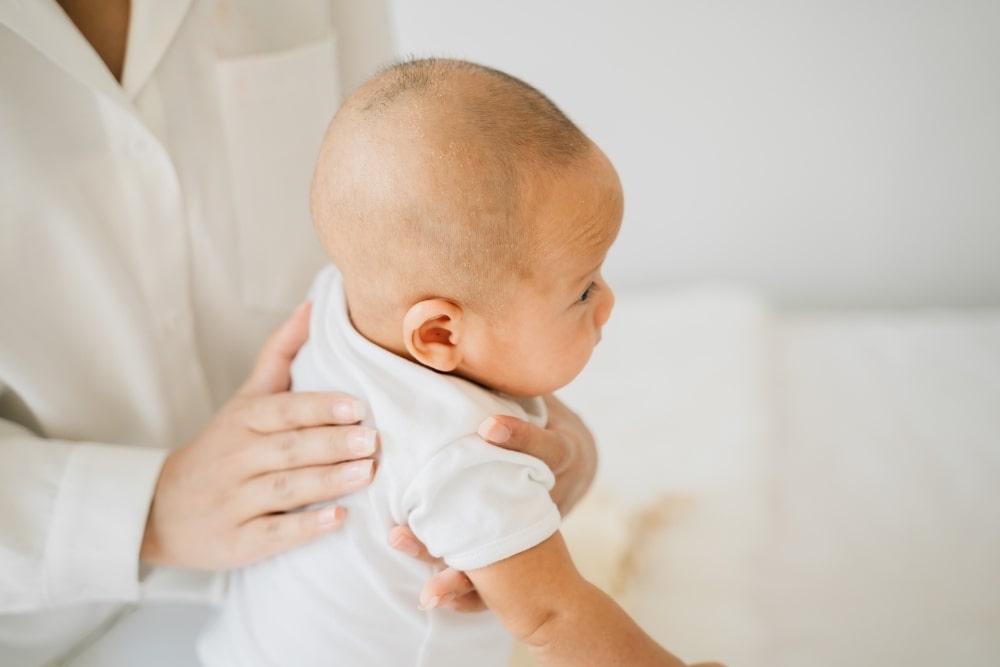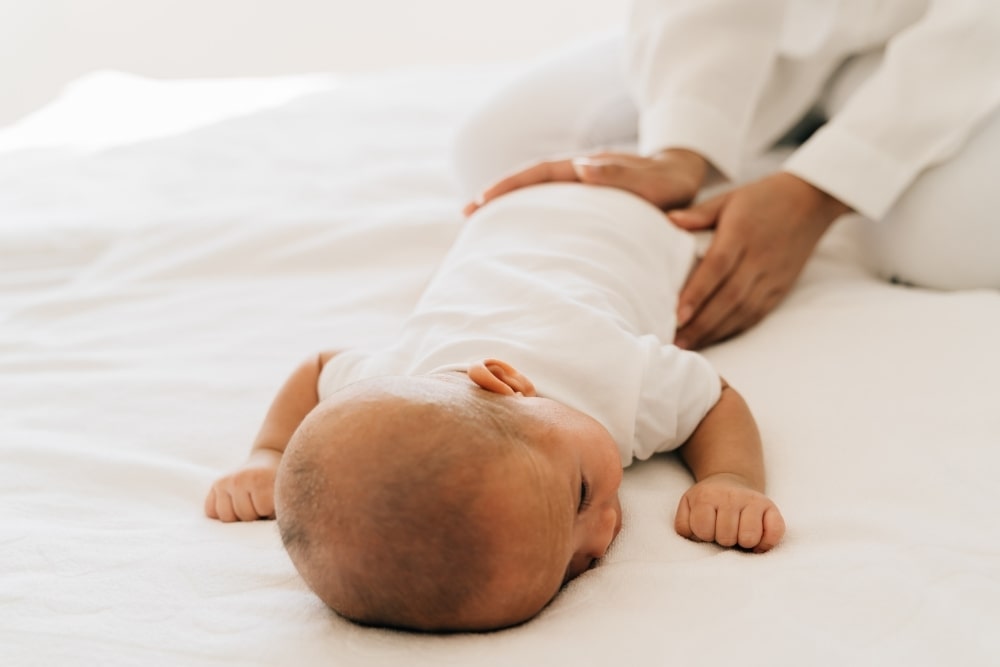One of the most entertaining things is your baby’s ability to burp super loud, I mean how can babies burp so incredibly loud?
The sound of it makes everyone in the room laugh since such a loud noise is coming from such a tiny human.
Even though these burps get everyone laughing, the reality is that burps are necessary for newborns to feel their best. Burps relieve air that is built up in the tummy of a newborn.
What you hear as a loud burp coming from your little one, is really a huge relief to them when they let it out. Trapped air causes painful stomach aches for your baby. And when you hear your baby burp it’ll possibly cause them to spit up when they do it too.
The problem for most babies comes down to getting the air that’s been trapped out of their belly. A baby’s anatomy certainly has the ability to release air after each feeding, the issue is that it’s a bit harder to do this when they spend most of their time laying down.
A good burp is something that every baby needs to feel better. We all know how much having pent up air in our bellies can make us feel sick. Imagine not being able to get the air out of your own stomach once it was in there.
Babies need their parents to give them that extra little nudge or pat on the back to finally release any air stuck in their belly.
How Does Air Get Into A Baby’s Belly?
Air gets trapped in a baby’s stomach for a variety of reasons such as; bottle feeding, breastfeeding, and even a winded cry.
Any of these ways can cause excess air to stay in their belly for a long time, and once it’s stuck in their belly, it’s our job as parents to help them get it out. Otherwise, the air will have to travel a long journey through the intestines to get out the other end.
When the air gets trapped from a baby drinking their bottle you can do this to minimize it
One of the most common reasons for air to get trapped in your baby’s stomach is when they drink a bottle.
There are a few different reasons why this happens, but you can look out for these signs, which are the most common reasons your baby is swallowing air while drinking their bottle.
Nipple hole size
If the nipple hole size in your baby’s bottle is too big it will cause your baby to suck the milk in way too fast. This causes the baby to gulp in huge pockets of air along with their milk.
[amalinkspro type=”showcase” asin=”B015XBYDLM” apilink=”https://www.amazon.com/dp/B015XBYDLM?tag=mominformedcom-20&linkCode=osi&th=1&psc=1″ new-window=”true” addtocart=”false” nofollow=”true” sc-id=”4″ imgs=”LargeImage” link-imgs=”false” specs=”Medium-flow nipple works with internal vent system for paced feeding~~~Each Level 2 Nipple has same consistent flow, so both you and baby know what to expect~~~Made of super-soft, high-grade silicone~~~Fits Dr. Brown’s Natural Flow Bottles and Dr. Brown’s Options Bottles~~~The suggested age range for the Level 2 nipple is 3 months+ but baby’s preferred flow rate may vary” btn-color=”#ff9900″ btn-text=”Buy on Amazon” alignment=”aligncenter” hide-prime=”0″ hide-image=”0″ hide-price=”0″ hide-button=”0″ width=”750″]Dr. Brown’s Original Nipple, Level 2 (3m+), 6 Count[/amalinkspro]
When the nipple holes are too big, the milk pours out super-fast making it difficult for your baby to keep up with the pace while swallowing.
If the bottle that your baby is using drips faster than one drop of milk per second, the nipple hole is too large.
You can perform the drip test by doing the following; make sure the formula or milk in the bottle is cold before performing the drip test, hot milk will naturally flow out much faster.
The position your baby eats in matters
When your baby eats laying back can cause more air to get stuck in their belly during a meal. Babies should always sleep laying on their back, but eating this way is not preferable.
View in gallery
Try to sit your baby upright or slightly up during a meal, and as much as possible throughout the day as well. The more your baby can be in an upright position the easier it will be for their body to release air in their belly by themselves.
The type of formula you use in their bottle will make a difference in how much they burp
If improper foods are being fed to your baby it can cause excess air and gas to accumulate in the stomach.
For instance, if you were to give your baby who is under 12-months-old cow’s milk instead of breastmilk or formula, it would upset their stomach to a great degree. For babies who are under one-years-old their gut is not mature enough to digest cow’s milk.
[amalinkspro type=”showcase” asin=”B07N8SH932″ apilink=”https://www.amazon.com/dp/B07N8SH932?tag=mominformedcom-20&linkCode=osi&th=1&psc=1″ new-window=”true” addtocart=”false” nofollow=”true” sc-id=”4″ imgs=”LargeImage” link-imgs=”false” specs=”SOOTHING NUTRITION: Modeled after the complete nutrition & gentleness of breastmilk, this formula offers nutrition for babies up to 12 months experiencing colic, excessive crying, fussiness & gas~~~PROBIOTIC FORMULA: Good Start Soothe formula features prebiotics, Comfort Proteins & probiotics that improve the good bacteria in tummies & promote soft stools; Its our closest formula to breastmilk~~~~~~” btn-color=”#ff9900″ btn-text=”Buy on Amazon” alignment=”aligncenter” hide-prime=”0″ hide-image=”0″ hide-price=”0″ hide-button=”0″ width=”750″]Gerber Good Start Soothe Non-GMO Powder Infant Formula[/amalinkspro]
In addition, giving your baby a type of formula that is not suitable for their age, and digestive abilities could result in them getting an upset stomach and later on having extra gas. Colic and gas go hand-in-hand, and a baby with colic and gas simultaneously will be extra fussy due to not feeling well.
How To Know If Your Baby Has air Trapped In Their stomach
The other day my baby seemed to be inconsolable, I didn’t know what else to do so I laid him down and began patting his back, we were both reaching the point of exhaustion. My husband then picked him up and gave him one big hard pat on the back – to which our baby let out the loudest burp I ever heard from his little body.
I’m glad my husband wasn’t afraid to pat his back harder than I usually do, because I couldn’t have thought what else I could do to soothe our baby. When it came down to it, our baby just needed extra help to get the rest of the air out of his stomach.
It’s important to know how a baby behaves due to an upset stomach, so you can help your baby when it happens. A baby who has air trapped in their belly will be extra fussy, sometimes grunting loudly, and wiggling around a lot in an attempt to get the air out.
Babies who have trapped air might cry loudly or even scream from the pain because having air in their stomach can hurt at times. You might notice your little one becoming obviously more distressed when you put them down without getting the air to come out.
Here Are A Few Of The Most Effective Ways to Help Your Baby With Burping
If your baby is unable to burp easily, they will need your help. Getting the air out of your baby’s belly is especially helpful to calm your baby who may be acting grumpy, angry, or unable to soothe.
At times my baby has become incredibly grumpy until I helped them get a huge burp out, then become completely calm.
This happens a lot more than we think, if you begin paying attention you might realize how much your baby is upset due to air in their belly’s.
You Can Bounce And Pat The Back Repeatedly To Help Them Burp
Many parents will lightly pat their baby’s back and get nothing in return, you might need to be a bit more firm when you pat your little one’s back to help them burp. Patting them more firmly might make you a bit nervous, but don’t worry – you aren’t going to hurt your baby with a firm pat.
View in gallery
If patting doesn’t help you to bring up the air, try to bounce your baby on your knee while you pat. This will move the air up and out of the belly more effectively.
Sometimes your baby needs to be pat in a different manner, you can also pat their bottom while bouncing them if the other methods don’t seem to work.
Find a pattern of bouncing and patting at the same time that works well for you and your baby.
Hold your baby exceptionally high up on your shoulder while patting their back
We’ve all seen a baby being patted high up on the shoulder, but when you’re performing this method it might feel different than it looks. You should place your baby as high up on your shoulder as safely possible – this might seem awkward at first.
Babies have quite a round belly so to put them so high up makes it feel like they’re about to topple over your shoulder completely. Just make sure that you have a good grip on their legs while you hold them that high up.
Many parents place their baby far too low on their shoulders and the burping never avails – you need to put your baby way up high on your shoulder.
After you have your baby on your shoulder you can lean back so that your baby is laying forward onto you, and won’t lean back themselves.
Your baby’s belly should be on your actual shoulder to push the air up and out of his belly.
Put Your Baby in a Football Hold and Burp Them on Their Belly
A football hold is one of the most effective ways to burp your baby if other more upright positions don’t work. Usually, you can do this right after a patting session to get all the air out of their stomach.
Simply lay your baby down on their belly, either on your leg or in your arm like a football. Babies wiggle around a lot, and this helps push the air out. You’ll probably hear the air come right out after you lay them on their belly.
If they aren’t wiggling much when you lay them down, you can pat their bottom to help them wiggle the air out. Babies are usually very happy with this position as long as they are over a month old, when they are younger than that it can cause them to faceplant.
Since their neck isn’t strong enough to hold them up in this position. You can help your baby turn their head to the side if they seem too tired to do it themselves.
View in gallery
Don’t leave small babies in this position because it can become hard for them to breathe quickly, and their cry could be muffled by the floor.
Stay with your baby at all times if you choose this method to relieve gas. Not only does this relieve gas, but it also helps strengthen the back muscles to help with sitting up.
Switch Up The Positions you’re burping your baby in frequently
Some mothers will keep their baby in one position, and expect a big burp to happen at some point. Well, burping your baby doesn’t have to be that timely – you should be able to get the air out fairly soon after a meal.
If your baby isn’t burping with you throwing them over your shoulder, then try the football hold right away. Move your babies’ legs in the bicycle and then turn them over on your lap – they don’t have to stay in one position to stay happy.
They like change as much as we do when our arms need a rest from holding them in one position too long. Talk to your baby about what you’re doing to keep them engaged and happy in the routine.
Stretching your baby’s legs and arms out can help their body as a whole, making more space for food the next feeding.
Sometimes they just need to stretch out and take up more space to get the air out. Sometimes the movement is all they really needed to get the job done.
When Gas is Too Stubborn for Bouncing You’ll Need to Perform gas relieving Exercises
In the case that certain patting or bounces simply aren’t working – you will need to do certain exercises or positions with your baby to help release the air in their belly.
Oftentimes positions are more important than the repetitive motion involved in bouncing. It’s more about the way your baby is positioned in tune with the route the air can escape their little bodies.
Rotations can help expel the air in your babies belly
If you sit your baby upright and rotate their body in a clockwise rotation it could help relieve the air inside your little one’s stomach. When your baby is sitting up, use your hand to hold your baby’s chest when doing this movement.
Once you do a few rotations clockwise, repeat it in the opposite direction.
Move your baby forward and backward
Sit your baby upright, then begin gently leaning your baby forward for a few moments – then lean your baby back toward the laying position without setting your baby all the way down.
Your baby might seem wiggly while performing this, so adjust the speed of the forward and backward rock according to your baby’s mood that day.
Knee to elbow touches can help expel farts and make your baby burp too
Have you ever done knee to elbow touches in highschool PE class? Where you do an intense crunch while touching your right knee to your left elbow and vice versa? Well, if so, then you can visualize this activity while you perform it on your little one.
Take your baby’s right elbow and bring it inward to the chest toward the left knee. Bring the left knee up and into the abdomen towards the elbow.
This motion together will squeeze out any remaining gas or air in your little one’s stomach and intestines.
View in gallery
A Tummy Massage Can Help your Baby Burp and Relieve Gas Too
Some nurses try to teach this technique to new mothers, it’s called the “I Love You” tummy massage. You basically try to spell out the letters “I” “L” and “U” in a gentle motion to stimulate burps and farts to naturally happen.
You can perform this tummy massage on your baby anytime after your baby is born. Relieving constipation, burps, and air in the intestines with this massage is something you can perform anywhere and any time of day or night easily.
Burp Your Baby At The Halfway Point of their Meal if You Breastfeed
If you’re breastfeeding your baby it’s best to do the burp session right in the middle of the meal. Let your baby eat of the right breast, give a good burp, and then transition your baby off to the left breast for the second half of their meal.
Doing it this way makes sure that the air bubbles are released before the second set of milk fat is piled on top of them.
In each breast, fat is released in the foremilk, and then more liquidy energy-based milk is the second to come. The halfway point is just best overall for a burp.
Burp a Bottle-fed Baby after every 3oz of milk consumed
If your baby drinks milk from a bottle, then the type of bottle being used determines how often one should burp their baby. When using a ventilated bottle you don’t have to burp too often, but with a non-ventilated bottle, you will need to burp every 3oz.
Ventilated bottles do the burping for you in a sense, they don’t allow air to build up that babies would otherwise suck down. Try not to wake your baby up irrationally for a burp session, aim to do it before the feeding is coming to an end.
In Conclusion
Relieving the air in your little one’s tummy is a top priority as a parent – hearing your baby fuss over an upset stomach is pretty difficult to sit through – especially when your know there are numerous ways to soothe their gas issues right at home.
If your baby is showing signs of having trapped air after drinking their milk, the tips listed in this article should help relieve them.
After you’ve performed all the tips in this article to relieve your baby’s extra air, you should move onto evaluating your eating habits if you breastfeed, or the formula that your baby is drinking if they still don’t seem to get any relief from you physically relieving the gas trapped in their belly.
Babies tend to tell their parents in all kinds of ways that they need to burp, but the most common signs that your baby needs to be burped include; being fussy, crying moe, and making wiggling motions for no other reason. Pay attention if it seems your little one is telling you they have air trapped in their stomach and need your help.
Sources
5 Tricks to Help Relieve Baby Gas






